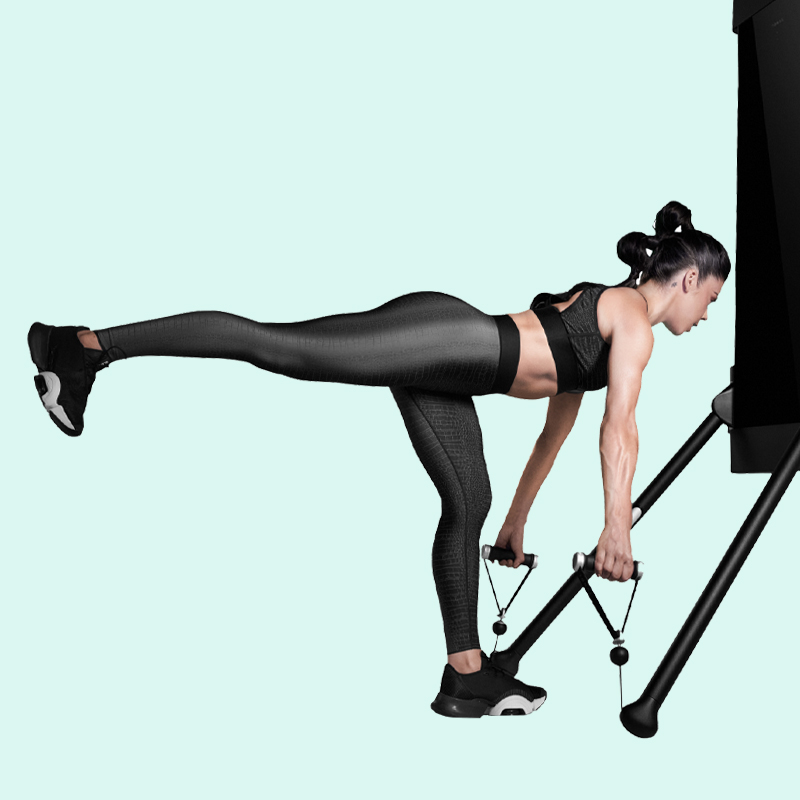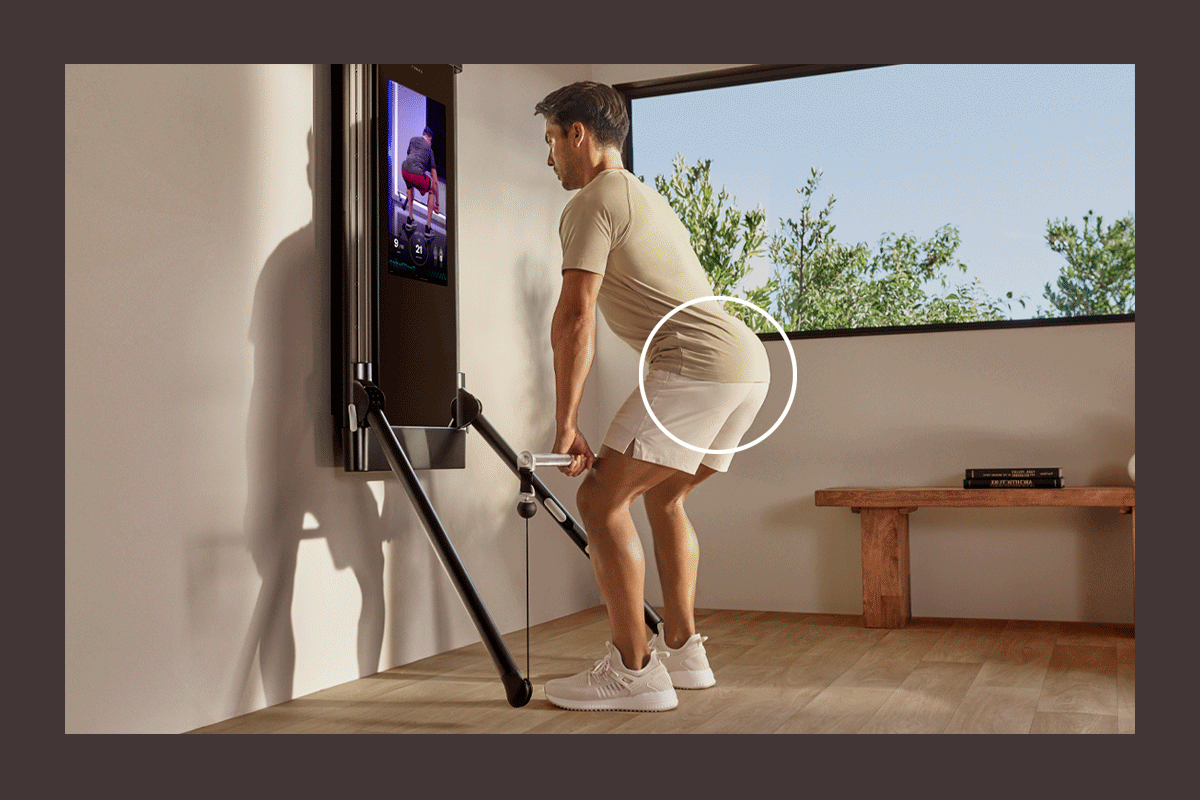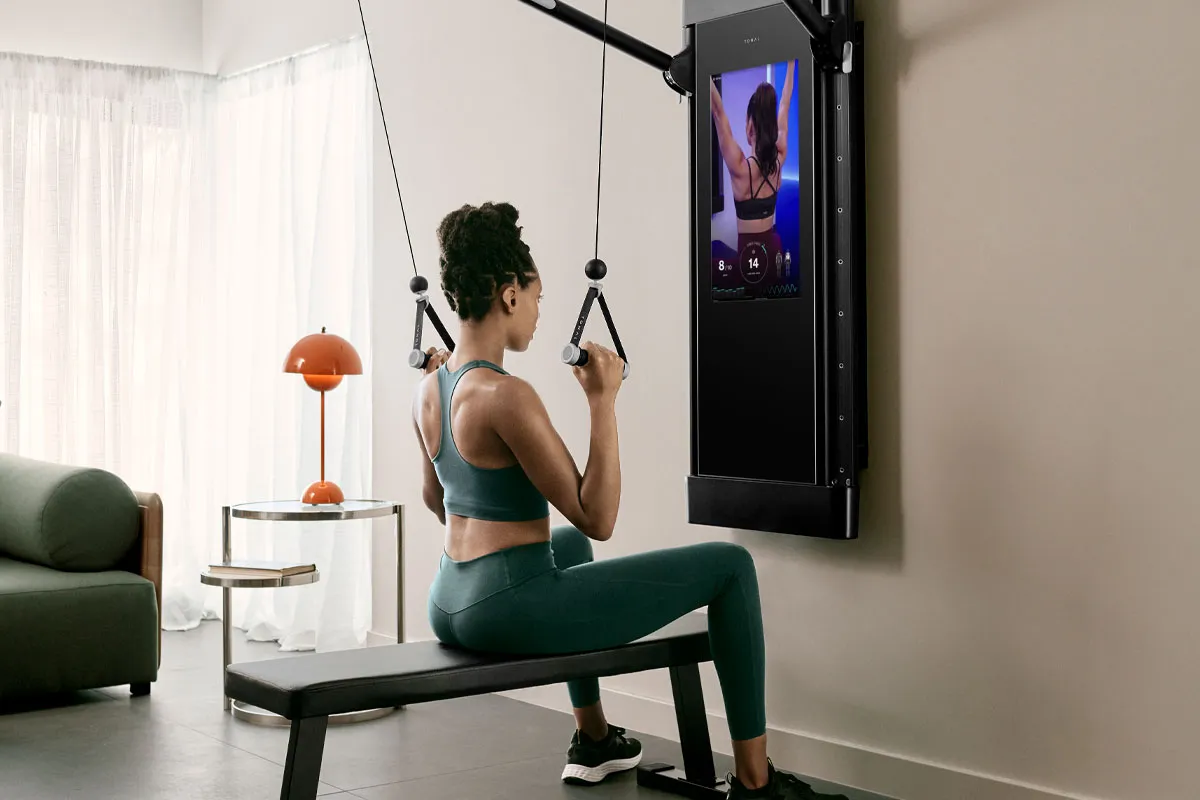Try these hamstring workouts to build stronger legs, prevent injuries, and find relief.

As a former professional dancer who’s suffered multiple hamstring tears, Jenna Moore, a certified strength and conditioning coach and Programming Specialist at Tonal, knows strong hamstrings are essential for healthy movement.
“Strengthening my hamstrings and keeping them strong is something I have to do consistently to avoid potential re-injury,” she says. “With any sport that requires a wide range of motion —it could be martial arts, dance, gymnastics, or ice skating—we often end up with weak hamstrings.”
That’s because strength must be maintained throughout the entire range of motion when you’re flexible, and flexibility training often becomes a priority over strength.
Even if you don’t play a sport, strengthening your hamstrings (which are a group of three muscles that stretch down the back of your thighs from your hips to just below your knees) will help you move better in everyday life and in your workouts.
“A lot of times people will think their hamstrings are tight, but really, they’re weak,” says Moore. “Weakness can manifest itself as a sensation of tightness. A lot of people don’t realize that strength training can be loaded stretching. It’s an area that people tend to neglect, and it’s an area that a lot of people can benefit from strengthening.”
If you want to give your hamstrings some much-needed attention, try one of these two hamstring workouts at home. Both workouts should take under 20 minutes to complete, and the first can be done with just your body weight.
Bodyweight Hamstring Workouts at Home
Even if you don’t have any gym equipment, you can still get a solid hamstring workout at home with bodyweight exercises. Moore recommends doing these exercises for time instead of reps.
“That way, you can work at your level and do the number of reps that work for you in a given amount of time,” she says.
Beginners should start by performing 1 to 2 rounds of the four exercises below for 30 seconds each. Moore says intermediate and advanced exercisers can progress to 4 to 5 rounds.

Nordic Hamstring Curl
Why it Works: Moore calls this move her “number one go-to” bodyweight exercise when it comes to hamstrings. “It is by far one of the best things you can do to really strengthen your hamstrings and prevent injury,” she says. The Nordic hamstring curl activates all three muscles that make up the hamstrings and, with an emphasis on the eccentric (lowering) phase of the movement, it’s a powerful strength builder. Moore stresses moving as slowly as possible in the movement.
How to Do it: Kneel on a mat with your feet held in place by a partner or a sturdy object that can support your weight. With your arms by your side, slowly lower yourself to the ground while keeping your back straight. Lower as far as you can while using your leg muscles and then catch yourself with your hands. Squeeze your hamstrings to raise yourself back up to the starting position, using your hands as needed.
Hamstring Walkout

Why it Works: This challenging move also targets all three hamstring muscles as well as your glutes. As you work through the exercise, you’ll test your hamstring strength at different degrees of knee flexion.
How to Do it: Lie face up on your mat and bring your heels to the floor just below your glutes, with your toes lifted and knees toward the ceiling. Walk your heels out until both legs are almost straight, keeping your glutes lifted off the floor. Walk the feet back in and repeat.
Glute Bridge

Why it Works: If the hamstring walkout is too difficult, Moore recommends starting with a basic glue bridge to activate the posterior chain. Build up to holding the position for longer periods of time, then progress to a single-leg glute bridge (with one leg elevated) or hamstring walkout.
How to Do it: Lie on your back with your knees bent and feet planted on the floor hip-width apart. Press the floor away from you, squeezing your glutes to lift your hips toward the ceiling. Lower the hips with control and repeat.
Good Morning
Why it Works: If you’ve done a Tonal workout that’s heavy on deadlifts, you’ve likely seen your coach incorporate this move into the warmup. Moore explains that’s because it preps your hamstrings for the hip hinge pattern of the deadlift while also providing a gentle stretch. “It acts as a good warm-up exercise, but it’s also just a good strengthening exercise to do with body weight,” she says.
How to Do it: Stand with your feet hip-width apart with your hands behind your head, elbows open to the sides. Keep your spine neutral and a slight bend at your knees as you hinge forward at your hips, reaching your glutes to the wall behind you. Return to standing by engaging your glutes and hamstrings.
Hamstring Workouts at Home with Resistance
To take your hamstring workouts to the next level, you’ll need to incorporate resistance. On Tonal, you’ll get personalized weight recommendations for each exercise for a safe and effective workout.
Since all of these moves target the hamstrings, Moore doesn’t recommend doing them as a circuit. Instead, mix it up with core or upper-body exercises in between the moves to give your hamstrings a break, or perform the moves with a long rest period after each exercise. However you choose to structure the workout, Moore recommends 8 to 10 reps of each of the moves below.
RDL (Romanian Deadlift)

Why it Works: Moore likes this exercise because it strengthens the hamstrings in the lengthened position which is typically where most people are weakest. For even more of a challenge, she suggests adding Eccentric Mode to add load as the hamstrings lengthen.
How to Do it: With feet hip-width apart and toes lined up with the end of Tonal’s arms, take a handle in each hand, and stand tall. With palms facing behind you, slide your hands down your thighs as you reach your hips back like someone is pulling you from behind. Squeeze your glutes and power your hip forward to come back up to standing, sliding the handles up your legs.
Single-Leg RDL

Why it Works: The single-leg RDL challenges your balance and stability while helping you identify any strength asymmetries between your legs. “If you have a history of injuries in one leg, the single-leg RDL variation is great because it’s going to help you with those asymmetries,” says Moore. “The unilateral version is really good to balance yourself out.”
How to Do it: Lift your opposite leg straight back like you’re trying to kick the ceiling with your heel, dropping your upper body as the leg lifts. Imagine your torso is a barbell reaching from your heel to your head, keeping your body straight. Use the glutes of the planted leg to power the torso back up and repeat on the same side.
Pull Through

Why it Works: If you’re new to lifting, Moore recommends starting with the pull through rather than the RDL. It’s a slightly easier move that still challenges your hamstrings while helping you master the hip hinge pattern you’ll need for deadlifts.
How to Do it: Take the rope in both hands and face away from Tonal. Bring the cable between the legs. Take a few steps away from Tonal and stand tall with feet hip distance apart and knees soft. Hinge at the hips like someone is pulling you from behind toward Tonal as the rope moves between the legs. Squeeze the glutes and power the hips forward to stand tall.
Barbell Sumo Deadlift

Why it Works: “Deadlifts are a full-body movement,” says Moore. “You’re going to target your hamstrings, but you’re also going to feel it in your glutes, your quads, and your back.” If you’re new to this compound movement, Moore suggests this wide-stance variation because it lightens the load on your back. “The sumo deadlift is a nicer place to start because it puts more of the focus on the glutes and the hamstrings,” she says, “The little bit of external rotation in the hips allows people to stay more upright in their torso.”
How to Do it: With your feet in a wide stance, stand by pressing the floor away from you and pulling the bar up the thighs. Reach your hips back to the wall behind you and bend your knees, sliding the bar down the legs to return to start. Imagine your back is as straight as a wall.
Resisted Lateral Lunge

Why it Works: When training the hamstrings, you can’t neglect side-to-side movements that you’ll likely encounter in your everyday activities. “Moving in multiple directions keeps our bodies resilient,” says Moore. The lateral lunge incorporates the hip hinge pattern so you’ll get plenty of glutes and hamstring activation.
How to Do it: Take the handle in one hand and take a few large steps away from Tonal. Stand sideways so the handle is on the far side of your body with the cable crossing in front of you. Take a wide step toward Tonal and sit back into your inside leg like you’re sitting in a chair while keeping the other leg straight. Press the floor away from you with the inside leg and return to standing. Repeat on the same side.
Tonal Hamstring Workouts You Can Do at Home
If you want to do a hamstring workout at home on Tonal, you can program the exercises above into a Custom Workout on the Tonal mobile app. Tonal also offers several coach-led workouts with expert guidance geared toward hamstring strength.
Leveled Up Leg Day – Coach Ash Wilking
This lower-body workout includes several of the moves listed above with the addition of plyometrics to really bring the burn to your legs.
High-Powered Lower Body – Coach Allison Tibbs
There’s lots of volume in this advanced-level workout to help you build muscular endurance as you strengthen your hamstrings and glutes.
Efficient Lower Body – Coach Frances Flores
In less than 30 minutes, you’ll push through compound lifts that target the lower body and recover with active stretching.
Lower Body Build – Coach Nicolette Amarillas
In this workout, you’ll build power and strength in your legs and glutes and even get a chance to work on your core.


